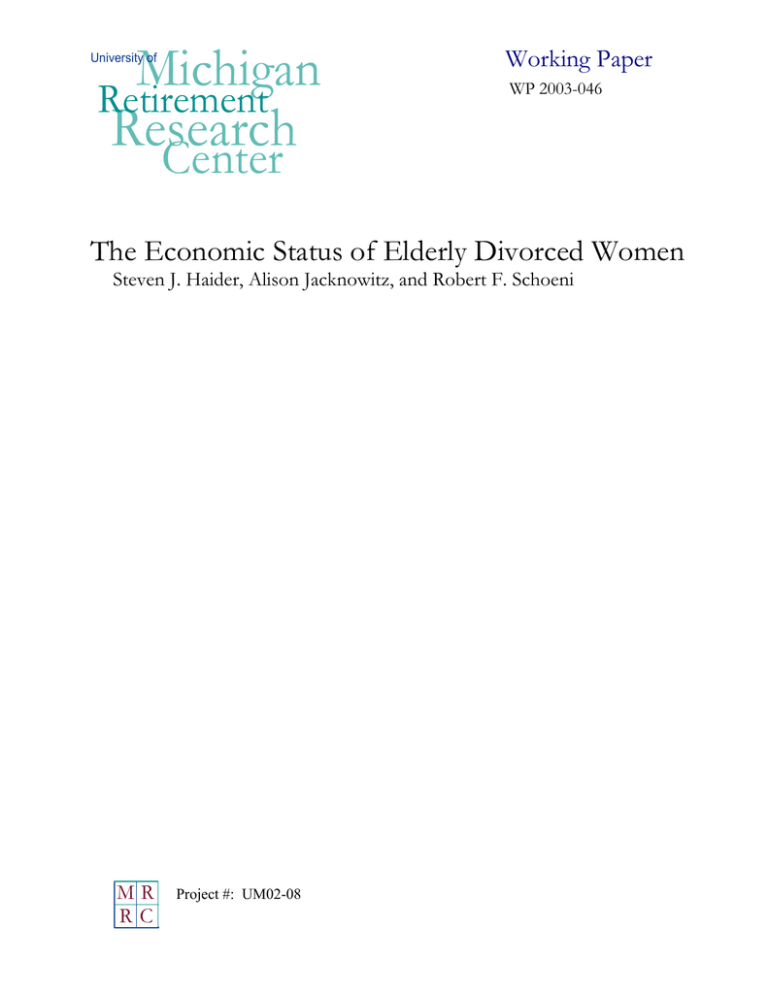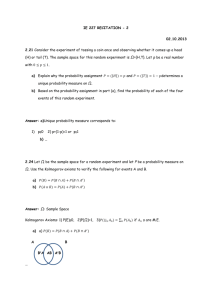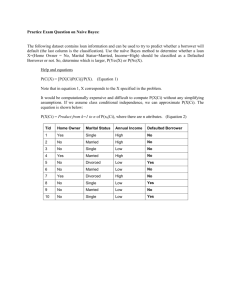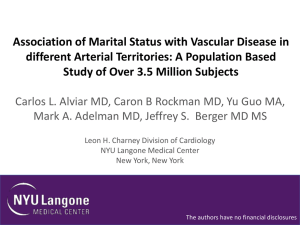Research Michigan Center Retirement
advertisement

Michigan Retirement Research University of Working Paper WP 2003-046 Center The Economic Status of Elderly Divorced Women Steven J. Haider, Alison Jacknowitz, and Robert F. Schoeni MR RC Project #: UM02-08 “The Economic Status of Elderly Divorced Women” Steven J. Haider Michigan State University Alison Jacknowitz RAND Robert F. Schoeni University of Michigan May 2003 Michigan Retirement Research Center University of Michigan P.O. Box 1248 Ann Arbor, MI 48104 Acknowledgements This work was supported by a grant from the Social Security Administration through the Michigan Retirement Research Center (Grant # 10-P-98358-5). The opinions and conclusions are solely those of the authors and should not be considered as representing the opinions or policy of the Social Security Administration or any agency of the Federal Government. Regents of the University of Michigan David A. Brandon, Ann Arbor; Laurence B. Deitch, Bingham Farms; Olivia P. Maynard, Goodrich; Rebecca McGowan, Ann Arbor; Andrea Fischer Newman, Ann Arbor; Andrew C. Richner, Grosse Pointe Park; S. Martin Taylor, Gross Pointe Farms; Katherine E. White, Ann Arbor; Mary Sue Coleman, ex officio The Economic Status of Elderly Divorced Women Steven J. Haider Alison Jacknowitz Robert F. Schoeni THE ECONOMIC STATUS OF ELDERLY DIVORCED WOMEN Steven Haider, Alison Jacknowitz, Robert Schoeni I. INTRODUCTION One of the most significant demographic changes in the past three decades has been the rise in divorce. Between the mid-1960s and late 1970s, the divorce rate doubled. Even though divorce rates leveled off in the 1990s, today 50 percent of marriages are expected to end in divorce (NCHS, 2001). While remarriage is fairly common, many divorcees do not find a new spouse. Moreover, second and third marriages are more likely to end in divorce than are first marriages. The cohorts of women who experienced the large increases in divorce in the 1970s were in their 20s and 30s at that time. The leading edge of these cohorts, who were born in the 1940s and 1950s, is now beginning to enter old age. As a result, the share of women 55-60 years old who are currently divorced rose from 4.8 percent in 1970 to 18.7 percent in 2002. While this cohort is the leading edge of the divorce revolution, they are also the leading edge of the baby boom. The aging of the baby boom cohorts has been a driving force behind discussions of changing old-age support policies, but the fact that these cohorts will be fundamentally different from earlier cohorts with regards to their marital history has received very little attention. Although the share of older women who are divorced has been relatively low historically, elderly divorced women have always been an unusually disadvantaged group. In particular, 22 percent of divorced women 65 and older lived in poverty in 2001. Although this is almost half the rate that existed in the late 1960s, it is nearly five times higher than the rate for married women. The rate is also higher than for elderly widows 1 (16 percent), who have been the focal point of the discussions of the distributional effects of old-age policies. Public policy may influence the economic status of divorcees in a number of ways. At the time of divorce, laws guide the division of resources between spouses, including pensions, and these laws vary across states. In old age, Social Security provides distinct benefits to divorcees, the amount being determined by a variety of factors including the length of marriage, ex-spouse’s earnings history, and whether the ex-spouse is alive. Despite these developments, little is known about the economic status of elderly divorced women. Our search found just five published studies on the topic. As a result, it is important to establish some of the basic facts, which is the central objective of this paper. Specifically this study: 1. Explores the differences in the socio-demographic characteristics of divorcees relative to other older women, with attention given to changes over time in the disparities. That is, do today’s elderly divorced women look more like married women than was the case 20-30 years ago? And how do divorced and separated women differ? 2. Examines the trends in poverty over the past three decades focusing on four questions: How does poverty of divorcees compare with women of other marital status over the past 30 years? How much lower would old-age poverty be today had divorce rates not risen? Has the poverty and SSI population become dominated by divorcees? How powerful have expansions of divorcee benefits been in lowering poverty? 2 3. Documents the disparities in income and wealth between elderly divorced women and other older women and answers four questions: How important are the different sources of income, such as Social Security and Supplemental Security Income, for each group? Are there disparities in assets and if so how large are they? What is the retirement pattern of divorcees? Do divorcees have much time to re-optimize their economic affairs after divorce? II. BACKGROUND Changes in the Marital Status Composition of Elderly Women Divorce was relatively uncommon in the United States through most of the 1940s, 1950s, and 1960s, with roughly 10.0 divorces per 1,000 married women in a given year (Figure 1). But within one decade -- between 1965 and 1975 -- the rate doubled to 20.3 per 1,000 married women. And that higher rate has held steady ever since, with rates of roughly 20 per 1,000 in the 1990s. Divorce is heavily concentrated among younger women (Table 1). In 1970 when the overall rate was 14.0 per 1,000 married women, the rate was 33.3 for women 20-24, declining to 18.9 for women 30-34, and 11.9 for women 40-44. Elderly women rarely divorce, with a rate of just 2.3 among 60-64 year olds and 1.3 for women 65 and older. All age groups experienced an increase in divorce between 1970 and 1990, although the smallest increases were for older women. As a result, divorce continued to be much more common among women under 30. Women frequently remarry, with 75 percent of divorced women remarrying within 10 years (NCHS, 2001). However, 26 percent of second marriages dissolve within 10 years. 3 As a result, many women enter old age as divorced. Moreover, divorce is much more common among lower income, less educated, and minority populations (Table 2), resulting in greater shares of these women at risk in old age. The cohorts of women who experienced the rapid rise in divorce in the 1970s were in their 20s and 30s at that time. Today these women are in their 50s and 60s, entering retirement and older ages. Because of the changes in marriage, divorce, and remarriage, the share who are divorced is much higher than in earlier birth cohorts. Butrica and Iams (2000) estimate that, at age 67, the proportion of the 1931-35 female birth cohort that is divorced is 12 percent. But for the birth cohort born just 20 years later in 1951-55, they project that 20 percent will be divorced at age 67. Moreover, many of the older women whose current status is not divorced will have experienced divorce at some point in their lives. In sum, the cohorts entering old age and becoming Social Security beneficiaries in the coming years will have experienced a much different marital history than previous cohorts. Laws and Policies Affecting Divorcees’ Social Security Benefits and Pensions Two of the most important sources of income for the elderly are Social Security benefits and pensions, and laws and policies influence the amount of these resources available to divorcees in old age. Social Security Benefits. During the first two decades of the Social Security program, elderly divorcees had no claim on benefits associated with their ex-spouse’s earnings history. But as the number of divorced elderly grew, so did the pressure to provide some type of Social Security benefits to divorcees. The first divorcee benefit was established in 4 1965 and was available to people 65 and older who were married to their ex-spouses for at least 20 years and who were determined to be dependent upon their ex-spouse. In this case the divorcee received 50 percent of the ex-spouses PIA while the ex-spouse was alive, with a reduction 25/36th of 1% for each month under age 65 that the divorcee received the benefit, with a minimum age of 62. If the ex-spouse died, the divorcee would receive a surviving divorcee benefit equal to 82.5% of the PIA beginning at age 60, with a reduction of 5/9th of 1% for each month under age 62. Remarriage prior to age 60 forfeits one’s surviving divorcee benefit; however, if the new marriage ends, whether by death, divorce, or annulment, then one is re-entitled to survivor’s benefits from the initial marriage. Remarriage at 60 or older allows the newly married wife to choose between the surviving divorcee benefit and the new spousal benefit, whichever is higher. Similar laws were put place for divorced husbands 12 years later in 1977. There was a cap placed on the divorcee benefit of $105 beginning in 1967, but this cap was eliminated in 1969. In 1972 the surviving divorcee benefit was raised from 82.5% of PIA to 100% of PIA. In 1977 the number of years required to be married to draw divorced spouse benefits was lowered from 20 years to 10 years, and the dependency requirement was eliminated. Like other benefits, the normal retirement age of divorcee benefits began increasing in 2000. In December of 2001, there were a total of 126,750 divorcees receiving divorced wives benefits and 330,590 receiving surviving divorced wives benefits, for a total of 457,340 (SSA, 2002, Table 5.A1.3). These benefits are received almost exclusively by women who are 62 and older, and the number of women 62 and older who are divorced was 2,094,000 in 2001 (estimate are based on authors’ tabulations of the 2002 March 5 CPS.) Therefore, roughly 22 percent of elderly divorcees receive divorcee benefits. Presumably the vast majority of elderly divorcees qualify for alternative benefits, such as their own worker benefits, which offer higher payments. However, one of the requirements to receive divorcee benefits is to notify SSA that one is in fact eligible for such benefits. Therefore, there may be some divorcees who are eligible for divorcee benefits that are greater than their current benefits, but they are unaware of this fact. This may be the case particularly when an ex-spouse dies and the divorcee benefit rises to from 50% to 100% of the ex-spouse’s PIA; there may be beneficiaries who would be better off receiving the surviving divorcee benefit who either do not know that their exhusband died or are unaware of the available benefits. Pensions. One asset that is particularly difficult to divide, but very important to the well-being of the elderly, is pensions. The difficulty in dividing pensions rests with pensions being only available in the future (for those who are still working) and being very complex in nature. For example, many pensions accrue to an individual in such a way as to make the final years of employment the most influential in determining the amount of pension benefits. It is not clear how any such accruals after the marriage has ended should be divided. Generally speaking, pensions can be and are often taken into account in the division of assets. The assets can be divided such that the entire pension remains with one individual (sometimes called the “immediate offset approach”) or that the pension payout is split between the two parties (sometimes called the “reserve jurisdiction approach”). When the pension is to be split at a later date, a Qualified Domestic Relations Order (QDRO) is filed with the pension plan administrator. The QDRO can specify two types 6 of payment schemes, a Separate Interest Payment scheme in which the pension can be completely split to give the recipient more control over how payments are received, and a Shared Payment scheme in which the recipient receives a portion of payments whenever the worker receives his. The primary laws that govern QDROs assure that the employer is not responsible for total payments that exceed what would have been paid if a divorce had not occurred.1 Thus, the actual fairness of the division of pensions rests with the formulas for division that are agreed to. III. DATA The analysis draws on two data sources: the Health and Retirement Study (HRS) and the March Current Population Survey (CPS). To document the economic disparities between divorced elderly women and married, separated, widowed, and never married women, we use the combined cohorts in the 1998 HRS.2 The 1998 HRS provides a large, nationally representative sample of individuals in the contiguous 48 states who are over the age of 50. Several advantages of using the HRS for this research exist. First, it 1 The one exception to this generality is that three states (Pennsylvania, Florida, and Indiana) require that pensions be appraised at the time of the divorce, called a Deferred Vested appraisal. These appraisals compute the value of the pension as of the divorce age, and thus ignore all future accruals. 2 The HRS was initially a longitudinal survey of people ages 51 to 61 in 1992 and their spouses. These individuals have continued to be interviewed every other year since 1992. Additional cohorts were subsequently added making the 1998 and 2000 waves a nationally representative sample of roughly 20,000 individuals born before 1947. We mainly rely on information from the 1998 HRS. We use information from previous surveys (including the Study of Assets and Health Dynamics Among the Oldest Old, the AHEAD) to determine the marital history for a respondent. 7 contains detailed questions about the financial situation of women of varying marital statuses. The HRS asks about multiple sources of income and assets and makes extensive use of unfolding brackets when collecting financial information, a technique shown to be highly effective (for example, Hurd et al., 1998).3 In addition, we have adequate sample sizes to examine differences in income and wealth by marital status. A variety of health status indicators are examined. The NAGY index is a count of the number of following activities a respondent has difficulty performing: walking several blocks, sitting for about two hours, climbing several flights of stairs without resting, lifting or carrying weights over ten pounds, and picking up a dime from the table. The ADL variable is a count of the number of following activities a respondent has difficulty performing: dressing oneself, walking across a room, eating, bedding, and toileting. The specific conditions examined include whether the person ever had: high blood pressure; diabetes or high blood sugar; cancer, excluding skin cancer; a heart condition; a stroke; arthritis; and lung disease such as chronic bronchitis or emphysema. For our HRS sample, we include female survey respondents who are 51 and older, whose household provided a family and financial respondent interview, who were not institutionalized, who had a non-missing weight, and reported their marital status. The final sample size is 11,182 individuals. Of these 11,182 respondents, 1,159 are divorced, 4,664 are currently married and have been married just once, 1,521 are currently married 3 The HRS provides imputations for many of the income and wealth questions, and we use these imputations whenever they are available. Imputations are not provided for the earnings and income of non-respondent co-residents. We imputed these values using a predictive mean matching methodology, similar to that employed by the HRS. See Haider, Jacknowitz, and Schoeni (Forthcoming) for a detailed description of these data. 8 but have been married more than once, 212 are separated, 3,265 are widowed, and 361 have never been married. The unit of observation for all of our analysis is the individual. For household variables like income or wealth, the values represent the total income or wealth for the household in which an individual resides. We also use the March CPS for the years 1968 to 2002 to examine trends in poverty and socio-demographic characteristics. The sample consists of roughly 50,000 households in each year, except in 2001 and 2002 when the sample was increased to roughly 90,000. These data are the source for the official government estimates of poverty rates for the nation. Because of the large sample sizes, there are ample numbers of divorced women 65 and older in the sample to examine in each year, with 614, 1,305, 1620, and 2167 such women in 1970, 1980, 1990, and 2000, respectively. IV. ANALYSES What Are the Characteristics of Divorced Women? Divorced vs Married Women Divorced and married women look very similar in terms of several key factors that are related to economic well-being. In Table 3 we report the socio-demographic and health characteristics by marital status separately for women 51-64 and 65 and older using the HRS. Among the younger group, divorced women are actually slightly more likely to have at least some college education: 47 percent versus 42 percent for oncemarried women. Divorced women are somewhat more likely to be non-Hispanic black: 16 percent versus 6 percent among once-married women. Among the older cohort (65 plus), divorced women are just as likely to have at least some college education (34 9 percent versus 35 percent), but they are also more likely to have less than a high school degree (32 percent versus 23 percent). Despite their similarities in education, divorced women are more likely to report some health conditions and disability. Among the younger women, limitations with activities of daily living (ADLs) are nearly twice as likely to be reported by divorced women – 27 percent versus 16 percent; large disparities exist among the older cohort as well, 41 percent versus 29 percent. For specific conditions, divorced women have a higher prevalence of diabetes, cancer, lung and heart disease. By contrast, never married women are much more likely than divorced women to be black (25 percent versus 16 percent) or Hispanic (13 percent versus 7 percent). However, a greater share of never married relative to divorced women are college graduates (26 percent versus 20 percent), and there are no systematic differences in health between the two groups among the array of health status measures listed in Table 3. As shown in Table 2, divorce rates are higher among less educated and lower income minority populations. However, with the rise in divorce, the question is whether the divorce population – specifically the elderly divorced population – is becoming more or less similar to the married population in terms of socio-demographic factors. We explore this issue by examining the education and racial distribution of elderly divorced and married women from 1968 to 2002. Specifically, in Figure 2 we display, for both divorced women 65 and older and married women 65 and older, the proportion who are high school dropouts and the proportion who are white. We see that the well documented improvements in education among these birth cohorts has also taken place among the divorced, with the proportion who are high school dropouts falling from 69 10 percent to 23 percent. The fall among married women – from 73 to 27 percent – is almost identical. The changes in the racial distributions are similar, with Figure 2 showing that the proportion who are white falling by 8 percentage points for married women and 10 percentage points among divorced women. In sum, this initial investigation suggests that the socio-demographic profile of elderly divorced and married women were fairly similar throughout the past 40 years. Divorced vs Widowed vs. Never Married Women Comparing the divorced and widowed women, the most important difference is age: widows tend to be older. This pattern is especially true for divorced and widowed women who are age 65 and older, where widows are over 5 years older (78.4 versus 73.1, see Table 3). Given this difference, it is not surprising to see that widows tend to be worse off in health attributes that tend to vary with age, such as the activities for daily living, the Nagy index, and high blood pressure. Perhaps one of the largest differences, however, is in education. Widows tend to have far less education than the divorced women. For example, 40 percent of widows age 65 and older have less than a high school education, whereas the comparable number for divorced women is 32 percent. Similarly, 9 percent of the same widows have a college degree but 16 percent of divorced women have a college degree. Turning to the never married women, they tend to have even more education than the divorced women, particularly at the highest levels of education. For example, 26 percent of the never married women age 51 to 64 have a college degree and 19 percent of the never married women age 65 and over have one. The corresponding percentages for the divorced women are 20 and 16 percent. There also exist substantial differences in race 11 between these two groups, but these differences are only observed for the women age 51 and 64. Divorced vs Separated Women Divorced and separated women are often grouped together in analyses of disparities in outcomes across marital states. However, the two groups are quite distinct. Twentyeight percent of separated women 51-64 were born outside of the United States, and 26 percent are Hispanic (Table 3). Another 20 percent of separated women in this cohort are non-Hispanic black, with less than half (42 percent) of this group non-Hispanic white. Elderly separated women, which account for 1.9 percent of all women 51 and older in 1998, are also much less educated than divorced women: while 47 percent of divorced women 51 to 64 have more than a high school degree, similar levels of education have been experienced by only 24 percent of separated women. Among the older cohort, the share without a high school degree is almost twice as high among separated women (61 percent) as it is for divorced women (32 percent). Despite this disadvantage among the older cohort, the prevalence of most chronic conditions is no higher among the separated women than among divorced women. However, among the younger cohort, there are indications that the health status of separated women is worse than the health status of divorced women. Understanding Trends in Poverty Among Divorcees The improvements in the economic status of the elderly over the past 4 decades has been well documented. As displayed in Figure 3, poverty rates among marred women have declined from 20 percent in the late 1960s to just 5 percent today. Widows have 12 been the focus of most of the discussion to address old-age poverty because such a large share of the elderly is widowed and poverty is so much higher for widows. In the late 1960s, for example, poverty was twice as high for widows (40 percent) than for married women. Like married women, poverty among widows fell substantially in the early 1970s. This fall is likely attributed at least in part to the increase in widow benefits to 100% of PIA in 1972 (Figure 4). However, gradual improvements have continued to be experienced at different points in the past three decades, with declines from 22 percent to 16 percent during the past 10 years. Poverty rates were similar between widowed and divorced elderly women in the late 1960s and early 1970s. And while divorcees experienced some important gains in the early 1970s, their poverty rates have remained remarkably high. Today almost one out of every four divorced women 65 and older lives in poverty. The trends in Figure 3 also suggest that divorcees economic status may be more sensitive to the business cycle, with large increases during the downturn in the late 1980s and early 1990s. This pattern is probably due to the fact that elderly divorcees rely disproportionately on labor market earnings for their income, which is discussed below. What Would Poverty Rate of Elderly Women Be if the Marital Status Distribution Had Not Changed? Given the rise in the prevalence of divorce combined with the fact that divorce women have a much higher poverty rate, it is natural to expect that the changing marital distribution has suppressed the amount of improvement in poverty among older women as a whole. In Figure 6 we display the poverty rate among all women 65 and older in 13 each year 1967 to 2001. We then display the poverty rate that would have existed had the marital status distribution remained fixed at its 1967 values, but letting the group-specific poverty rates to change with time. We see that poverty would have actually been slightly higher had the distribution not changed. This pattern is due to the fact that the proportion of elderly women who are widows fell from 33 percent to 26 percent, and widows have high poverty rates. Alternatively, we allowed the proportion of widows, never married, and separated women to change over time, but we held the proportion divorced constant at its 1968 level of 3.3 percent, and when divorce rose in subsequent years we assumed they would have been married. Using this alternative weighting scheme, we find that elderly female poverty would have been 11.3 percent instead of 12.4 percent, or roughly 10. That is, if divorced women had remained married, the simulation implies that poverty would have been roughly 10 percent lower than it current is. Has the Poverty Population Become More Heavily Composed of Divorced Women? With the rise in divorce, it is natural to expect that the share of impoverished women who are divorced will also rise. Using the CPS, Figure 7 shows the marital status distribution of elderly women in poverty in each year 1967 to 2001. The single largest group throughout the 30 year period is widows: widows accounted for 70 percent of poor elderly women in the early 1970s, and although their representation has declined, today they account for 60 percent of such women. The group that experienced the most rapid increase is divorced women. In 1970 just 2 percent of poor elderly women were divorced. Today, 15 percent of impoverished women 14 65 and older are divorced. This growth over the past 10 years has been quite rapid, and will most likely continue into the future. Figure 8 displays the marital status distribution among poor women who are today approaching old age. While 15 percent of all poor women 65 and older are divorced, the rate is 23 percent among poor women 60 to 69 years old, and 29 percent among poor women 51 to 59 years old. Similar trends exits within the elderly SSI population. Figure 9 shows the marital status distribution of women 65 and older on SSI in each year 1975 to 2001. While divorced women accounted for just 5 percent of the elderly female SSI population in the mid-1970s, that rate tripled by 2001 to 15 percent. In sum, the gap in poverty between divorced and married women has increased tremendously in the past 40 years. This is true of all marital states relative to the married women. Divorcees did not experience improvements that widows did in the early 1970s. At the same time, in terms of socio-demographic factors, divorced and married women continue to look quite similar. The question then becomes, with such similar sociodemographic qualities, why does their economic status differ so greatly? Differences in Economic Well-Being Across Marital States Not surprisingly, divorced women have substantially lower household income than married women. Among women 65 and older, average income was $27,512 for divorcees versus $49,588 for once-married women.4 Divorcees wealth holdings are a fraction of the 4 Estimates of the poverty rate for women 65 and older in the 1998 March CPS and the 1998 HRS align closely. 5.1 and 4.2 for married women, 17.9 and 16.9 for widows, and 21.6 and 21.6 for divorced women, respectively. 15 wealth holding for married women, with a median of $50,400 for divorcees versus $223,000 for once-married women (Table 4). Among unmarried women, however, divorced women are in relatively good financial position. Average income of divorcees is higher than that of separated, widowed, or never married women. For example, mean income among the women 65 and older is $27,512 for divorcees and $25,717 for widows. The differences are larger for women 51-64 years old. At the same time, the wealth holdings of divorces is not as high as it is among widows. Among the women 65 and older, average wealth holdings are almost 50 percent higher for widows than it is for divorcees. And this difference holds even despite the fact that among these women, widows are 5.3 years older (78.4 versus 73.1 from Table 3), have more health problems, and are probably nearer to death. The wealth tabulations also suggest that divorcees are both income rich and asset poor. That is, it is not the case that the majority of divorcees have high assets because of large marital dissolution settlements. The disparities in means and medians mask the fact that there is greater heterogeneity in economic status among divorcees. In Figure 10 we display the distribution of women 65 and older by income-to-needs ratio. As shown above, the share of women in poverty (i.e., with income-to-needs of 0-100) is much higher among divorced women than among widows. However, the share of women who have very high income – at least 500% of the poverty line – is greater among divorced women than among widows. Labor market earnings are a particularly important source of income for elderly divorcees. Among the 51-64 year olds, 60 percent of household income comes from the earnings of the divorcee (24902/40381 from Table 5). For widows, only about one-third 16 of income comes from labor market earnings. This is true even among women 65 and older; 14 percent of income comes from earnings of these older divorcees, on average. A second source of income that is especially important among divorcees, as well as all other unmarried women, is income from other household members. Divorcees and other single women draw a much larger share of their income from co-residents. For example, among women 65 and older, divorced women drew $4,950 of their $27,512 from co-resident’s income, while married women drew just $2,525 their $49,589. Retirement Patterns Among Divorcees Given the importance of labor market earnings to the economic status of older divorced women, we examine their retirement patterns. In Figure 11 is the familiar pattern of employment by age for married men (Quinn, 2000). (This is based on the 1998 to 2002 CPS merged together, using employment last week as the outcome.) As is well documented, employment declines rapidly as men age, falling from 90 percent at age 51 to 65 percent at age 61. The retirement hazard then increases sharply at ages 62 and 65, so that by age 65 just 38 percent of married men are working. By the mid-70s, only about 15 percent are still working. Divorced women have remarkably high employment rates, just as high as married men during most of old age. Married men’s rates are about 5 percentage points higher through the early 60s, but then the two are almost identical at all older ages. Divorced women also do not experience the well established large rise in retirement hazard at ages 62 and 65 which as been documented for men. For divorced women, the fall in employment between 61 and 62, and 64 and 65 is no greater than at surrounding 17 ages. Why divorced women do not show this common pattern that arises at least in part due to incentive effects of Social Security needs to be explored. V. DISCUSSION Until recent years, very few elderly people had ever experienced divorce. Most had been married to one person their entire adult lives. This pattern is changing rapidly. The sharp rise in divorce between 1965 and 1975, with persistently high rates ever since, implies that over half of marriages will end within 20 years. The birth cohorts that were the first to experience the rapid increase in divorce is also the leading edge of the baby boom, born primarily in the 1940s and 1950s. These cohorts are just now beginning to hit retirement ages. While 12 percent of today’s 67 year old women are currently divorced, within just 15 years this will rise to 20 percent. And a much larger share of women are ever-divorced – they divorced but then remarried. These trends alone warrant a close investigation of the economic well-being of elderly divorcees. However, combining these trends in divorce with the fact that elderly divorced women are 5 times as likely to be poor than elderly married women, and onethird more likely to be poor than widows, it is surprising to us that only a handful of studies have examined this population. The goal of this study is to begin to establish the stylized facts regarding the economic status of divorcees and describe some of the difficulties they face. While this paper is only the beginning of a series of studies that are needed to address a wide array of issues, it reaches some important conclusions: • Despite high poverty rates, divorced women are no less educated than married women; 18 • • • • • This similarity in education persisted over the past 35 years despite the fact that during the same time period the gap in poverty between these two groups increased from 2:1 (in 1967) to 4:1 (in 2001). Labor market earnings are a particularly important source of income for elderly divorced women; Divorced women’s level of labor force participation is comparable to that of married men; however, retirement of divorced women experiences no spike at ages 62and 65, as is the case for married men; Divorced women are quite distinct from separated women, with the latter much less educated, lower income, and minority; grouping these two populations together, as is often done, is a mistake; Initial analyses suggest that the reduction in the requirement on length of marriage from 20 to 10 years to receive Social Security divorcee benefits had little or no effect on alleviating divorcee poverty. A large number of questions remain unanswered, but given the speed at which the cohorts with high prevalence of divorce are approaching old age, the time is now to address these questions. 19 References Auerbach, Alan J., and Laurence J. Kotlikoff. 1987. Life Insurance of the Elderly: Its Adequacy and Determinant, In Work, Health, and Income Among the Elderly, edited by Gary Burtless, Brookings Press. Barusch, Amanda Smith. 2000. Social Security is not for Babies: Trends and Policies Affecting Older Women in the United States, Families in Society: The Journal of Contemporary Hman Services, pages 568-575 Burkhauser, Richard V., Karen C. Holden, and Daniel A. Myers. 1986. Marital Disruption and Poverty: The Role of Survey Procedures in Artificially Creating Poverty, Demography, 4(November): 621-631. Butrica, Barbara A. and Howard M. Iams. 2000. “Divorced Women at Retirement: Projections of Economic Well-Being in the Near Future,” Social Security Bulletin, 63(3): 3-12. Crown, William H., Phyllis H. Mutschler, James H. Schulz, Rebecca Loew. 1993. The Economic Status of Divorced Older Women, Policy Center on Aging, Heller School, Brandeis University. Cherlin, Andrew. 1992. Marriage, Divorce, and Remarriage. Harvard University Press. Duncan, Greg J., and Saul D. Hoffman. The Economic Consequences of Marital Instability. In Horizontal Equality, Uncertainty, and Economic Well-Being, edited by Martin David and Timothy Smeeding, The University of Chicago Press. Haider, Steven J., Alison Jacknowitz, Robert F. Schoeni. Forthcoming. “Food Stamps and the Elderly: Why is Participation so Low?” Journal of Human Resources. Saul Hoffman. 1977. Marital Instability and the Economic Status of Women. Demography, 14(1): 67-76. Holden, Karen C. and Hsiang-Hui Daphne Kuo. 1996. “Complex Marital Histories and Economic Well-Being: The Continuing Legacy of Divorce and Widowhood as the HRS Cohort Approaches Retirement, Journals of Gerontology: Social Sciences, 36(3): 383390. Holden, Karen C. 1989. Economic Status of Older Women: A Summary of Selected Research Issues, In Health and Economic Status of Older Women, edited by A. Regula Herzog, Karen C. Holden, and Mildred M. Seltzer, Baywood Publishing Company, Inc. Hungerford, Thomas L. 2002. “The Persistence of Hardship Over the Life Course,” Social Security Administration working paper. 20 Hurd, Michael D., Daniel McFadden, Harish Chand, Li Gan, Angela Merrill, and Michael Roberts. 1998. “Consumption and Savings Balances of the Elderly: Experimental Evidence on Survey Response Bias.” In Frontiers in the Economics of Aging, ed. David A. Wise, 353-87. Chicago: University of Chicago Press. Jacob, Herbert. 1989. Another Look at No-Fault Divorce and the Post-Divorce Finances of Women. Law and Society Review, 23(1): 95-115. King, Francis P. 1982. Occupational Pension Plans and Spouse benefits, In A Challenge to Social Security: the Changing Roles of Women and Men in American Society, edited by Richard V. Burkhauser and Karen C. Holden, Academic Press. McNamara, Tay K., Regina O’Grady-LeShane, and John B. Williamson. 2003. The Role of Marital History, Early Retirement Benefits, and the Economic Status of Women, Boston College Working Paper. Morgan, Leslie A. 1991. After Marriage Ends: Economic Consequences for Midlife Women, Sage Publications. National Center for Health Statistics. 2002. Vital and Health Statistics, Series 23, Number 22, July. National Center for Health Statistics. 1995. Monthly Vital Statistics Report, Vol. 43(9): Supplement, March 22. Ono, Hiromi, and Frank Stafford. 2001. Till Death Do Us Part if I Get my pension? Wives’ Pension Holding and Marital Dissolution in the United States, Scandanavian Journal of Economics, 103(1): 1-20. Preston, Samuel H./, Suet Lim, and S. Philip Morgan. 1992. African-American Marriage in 1910: Beneath the Surface of Census Data, Demography, 29(1): 1-15. Smeeding, Timothy M. 1999. Social Security Reform: Improving Benefit Adequacy and Economic Security for Women, , Syracuse University Maxwell School of Citizenship and Public Affairs, Policy Brief No. 16. Smock, Pamela J., Wendy D. Manning, and Sanjiv Gupta. 1999. The Effect of Marriage and Divorce on Women’s Economic Well-Being, American Sociological Review, 64(December): 794-812. Steuerle, C. Eugene. 1999. The Treatment of the Family and Divorce in the Social Security Program, Urban Institute, February 22. Uhlenberg, Peter, Teresa Cooney, and Robert Boyd. 1990. Divorce for Women after Midlife, Journals of Gerontology: Social Sciences, 45(1): S3-11. 21 Weaver, David. 1997. “The Economic well-Being of Social Security Beneficiaries, with an Emphasis on Divorced Beneficiaries,” Social Security Bulletin, 60(4): 3-17. Weitzman, Lenore J. 1985. The Divorce Revolution: The Unexpected Social and Economic Consequences for Women and Children in America. The Free Press Wilson AE. Hardy MA. 2002. Racial disparities in income security for a cohort of aging American women. Social Forces. 80(4):1283-1306, June. 22 Table 1. Number of Divorces and Annulments per 1,000 Married Women, by Age: 1970 and 1990 Age All ages 15-19 20-24 25-29 30-34 35-39 40-44 45-49 50-54 55-59 60-64 65 and older Source: NCHS 1995, Table 5. 1970 14.0 26.9 33.3 25.7 18.9 14.8 11.9 8.5 5.6 3.5 2.3 1.3 1990 18.7 48.6 46.0 36.6 27.9 23.1 19.3 13.8 8.2 4.8 2.9 1.4 23 Increase 33.6% 80.7% 38.1% 42.4% 47.6% 56.1% 62.2% 62.4% 46.4% 37.1% 26.1% 7.7% Table 2. Probability of First Marriage Disruption After 10 Years of Marriage by Selected Characteristics: Women 15-44 Proportion Disrupted After 10 Years 0.33 All Women 15-44 Race/ethnicity Hispanic Non-Hispanic white Non-Hispanic black Non-Hispanic Asian Education Less than high school High school More than high school Family income <$25,000 $25,000-49,999 >=$50,000 Source: NCHS, 2002, Table 21. 0.34 0.32 0.47 0.20 0.42 0.36 0.29 0.53 0.31 0.23 24 Table 3. Demographic and Health Characteristics of Elderly Women, by Marital Status Panel A: Age 51-64 Age US Born Hispanic Non-Hispanic-Black Non-Hispanic White Education <12 years 12 years Some college College graduate Nagy index ADLs Blood Diabetes Cancer Lung Heart Arthritis Unweighted N Divorced 56.7 0.91 0.07 0.16 0.74 Widowed 59.1 0.89 0.08 0.19 0.70 Never Married 56.5 0.88 0.13 0.25 0.58 Separated 57.0 0.72 0.26 0.20 0.42 Married (1 time) 57.3 0.89 0.08 0.06 0.84 Married (>=2) 56.6 0.91 0.03 0.06 0.89 0.17 0.35 0.27 0.20 1.31 0.27 0.36 0.12 0.11 0.10 0.12 0.48 782 0.35 0.36 0.18 0.11 1.37 0.33 0.46 0.13 0.06 0.10 0.13 0.56 665 0.21 0.32 0.19 0.26 1.50 0.36 0.47 0.10 0.13 0.07 0.08 0.56 198 0.49 0.27 0.13 0.11 1.60 0.44 0.49 0.17 0.09 0.12 0.14 0.45 151 0.17 0.40 0.22 0.20 1.00 0.16 0.34 0.09 0.08 0.05 0.10 0.47 2,715 0.21 0.35 0.28 0.17 1.16 0.21 0.36 0.09 0.09 0.10 0.11 0.49 969 Divorced 73.1 0.93 0.07 0.13 0.78 Widowed 78.4 0.92 0.04 0.10 0.84 Never Married 76.4 0.86 0.08 0.12 0.76 Separated 72.7 0.85 0.17 0.34 0.42 Married (1 time) 73.1 0.92 0.05 0.05 0.89 Married (>=2) 73.5 0.93 0.03 0.06 0.89 0.32 0.33 0.18 0.16 1.76 0.41 0.51 0.15 0.12 0.13 0.21 0.65 377 0.40 0.35 0.16 0.09 1.92 0.55 0.57 0.16 0.13 0.11 0.26 0.67 2,600 0.31 0.29 0.20 0.19 1.78 0.46 0.60 0.14 0.18 0.07 0.19 0.70 163 0.61 0.25 0.11 0.03 1.97 0.69 0.49 0.17 0.09 0.06 0.21 0.63 61 0.23 0.41 0.20 0.15 1.42 0.29 0.53 0.12 0.13 0.07 0.19 0.60 1,949 0.28 0.41 0.20 0.11 1.75 0.38 0.56 0.14 0.17 0.15 0.23 0.63 552 Panel B: Age 65 and Older Age US Born Hispanic Non-Hispanic-Black Non-Hispanic White Education <12 years 12 years Some college College graduate Nagy index ADLs Blood Diabetes Cancer Lung Heart Arthritis Unweighted N Source: Authors’ tabulations from the HRS. 25 Table 4. Total Income and Wealth of Elderly Women by Marital Status Panel A: 51-64 Divorced Income Mean Median Wealth Mean Median Widowed Never Married Separated Married (1 time) Married (>=2) 40,380 [1,290] 32,640 32,085 [1,172] 24,428 34,994 [2,627] 27,000 27,509 [2,338] 19,000 83,025 [1,723] 59,928 77,565 [4,643] 57,000 143,846 [14,704] 58,000 161,157 [13,630] 66,000 140,060 [36,643] 51,500 72,089 [9,244] 29,000 471,251 [21,886] 207,000 339,724 [21,886] 145,800 Panel B: 65 and Older Divorced Income Mean Median Wealth Mean Median Widowed Never Married Separated Married (1 time) Married (>=2) 27,512 [2,368] 15,600 25,717 [541] 16,300 23,791 [1,870] 17,406 15,414 [1,798] 8,328 49,588 [1,277] 34,768 43,670 [1,905] 32,454 147,844 [21,668] 50,400 203,801 [18,140] 90,570 173,526 [20,074] 76,000 61,270 [11,421] 27,006 420,602 [16,407] 223,000 326,597 [25,879] 160,000 Source: Authors’ tabulations from the HRS. Standard errors reported in brackets. 26 Table 5. Household Income of Elderly Women By Source of Income, by Marital Status Panel A: Average Income of 51-64 Year Olds Married (1 time) 83,026 54,878 3,617 1,316 4,902 13,221 5,091 Married (>=2) 77,566 52,632 3,819 1,642 4,082 12,356 3,036 Panel B: Income Relative to Once-Married Women 51-64 Year Olds Never Divorced Widow Married Separated Total 0.49 0.39 0.42 0.33 Earnings 0.45 0.23 0.44 0.25 Social Security 0.26 0.80 0.38 0.28 Government transfers 0.65 0.76 0.54 1.00 Pensions 0.25 0.44 0.36 0.13 Other 0.41 0.38 0.28 0.16 Income of co-residents 1.37 1.64 0.65 1.76 Married (1 time) 1.00 1.00 1.00 1.00 1.00 1.00 1.00 Married (>=2) 0.93 0.96 1.06 1.25 0.83 0.93 0.60 Panel C: Average Income of Women 65 and Older Never Divorced Widow Married Total 27,512 25,717 23,791 Earnings 3,785 1,156 1,381 Social Security 7,235 8,529 6,954 Government transfers 380 504 755 Pensions 5,370 2,984 4,413 Other 5,792 6,043 5,783 Income of co-residents 4,950 6,500 4,506 Married (1 time) 49,589 8,048 14,863 945 8,499 14,709 2,525 Married (>=2) 43,671 8,133 14,690 1,146 8,068 10,242 1,393 Married (1 time) 1.00 1.00 1.00 1.00 1.00 1.00 1.00 Married (>=2) 0.88 1.01 0.99 1.21 0.95 0.70 0.55 Total Earnings Social Security Government transfers Pensions Other Income of co-residents Divorced 40,381 24,902 958 861 1,206 5,475 6,978 Widow 32,085 12,668 2,877 1,001 2,135 5,046 8,359 Never Married 34,994 24,173 1,368 717 1,751 3,670 3,315 Separated 27,509 13,467 1,028 1,319 639 2,090 8,966 Separated 15,415 790 4,969 944 2,352 1,035 5,325 Panel D: Income Relative to Once-Married Women 65 and Older Never Divorced Widow Married Separated Total 0.55 0.52 0.48 0.31 Earnings 0.47 0.14 0.17 0.10 Social Security 0.49 0.57 0.47 0.33 Government transfers 0.40 0.53 0.80 1.00 Pensions 0.63 0.35 0.52 0.28 Other 0.39 0.41 0.39 0.07 Income of co-residents 1.96 2.57 1.78 2.11 Source: Authors’ tabulations from the HRS. 27 Divorces per 1,000 Married Women Figure 1. Trends in the the Divorce Rate 25 20 15 10 5 0 50 52 54 56 58 60 62 64 66 68 70 72 74 76 78 80 82 84 86 88 90 Year Source: NCHS Monthly Vital Statistics Report, Vol. 43(9): Supplement, March 22, 1995. 28 Figure 2. Education and Race of Elderly Divorced and Married Women: 1968-2002 1.00 0.80 Proportion 0.60 White/High School Drop Out 0.40 Married-White Married-Educ<12 0.20 Divorced-Educ<12 Divorced-White 0.00 '68 '70 '72 '74 '76 '78 '80 '82 '84 '86 '88 '90 '92 '94 '96 '98 '00 '02 Source: Authors’ tabulations from the CPS. 29 Figure 3. Trends in Poverty Among Elderly Divorced, Widowed, and Married Women 0.50 0.40 Poverty Rate 0.30 Divorced 0.20 Widowed 0.10 Married 0.00 '67 '69 '71 '73 '75 '77 '79 '81 '83 '85 '87 '89 '91 '93 '95 '97 '99 '01 Source: Authors’ tabulations from the CPS. 30 Figure 4. Expansion of Widow Benefits and Widow Poverty 0.50 Widow benefit increased to 100% of PIA 0.40 0.30 Poverty Rate 0.20 0.10 0.00 '67 '69 '71 '73 '75 '77 '79 '81 '83 '85 '87 '89 '91 '93 '95 '97 '99 '01 Source: Authors’ tabulations from the CPS. 31 Figure 5. Expansion of Divorcee Benefits and Divorcee Poverty 0.50 0.40 Poverty Rate Length of marriage required for divorcee benefits shortened from 20 to 10 years 0.30 0.20 Divorced Women 0.10 Cap on divorcee benefit of $105 eliminated 0.00 '67 '69 '71 '73 '75 '77 '79 '81 '83 '85 '87 '89 '91 '93 '95 '97 '99 '01 Source: Authors’ tabulations from the CPS. 32 Figure 6. Elderly Female Poverty RateWith Alternative Marital Distributions Actual 0.30 Holding Marital Status Constant Poverty Rate Assigning Change in Divorce to Married 0.20 0.10 '67 '69 '71 '73 '75 '77 '79 '81 '83 '85 '87 '89 '91 '93 '95 '97 '99 '01 Source: Authors’ tabulations from the CPS. 33 Figure 7. Trends in the Marital Status Distribution of Poor Elderly Women 100% 80% Never Married Separated Divorced Married Widowed 60% 40% 20% 0% '67 '69 '71 '73 '75 '77 '79 '81 '83 '85 '87 '89 '91 '93 '95 '97 '99 '01 Source: Authors’ tabulations from the CPS. 34 Figure 8. Marital Status Distribution Among Poor Elderly Women in 2000, by Age 100 80 Widowed Separated 60 Percent Married 40 Never Married Divorced 20 29 23 13 0 51-59 60-69 Age in 2000 Source: Authors’ tabulations from the CPS. 35 70-79 Figure 9. Trends in the Marital Status Distribution Among Elderly Women on SSI 100% 80% Never Married Separated Divorced Married Widowed 60% 40% 20% 0% '75 '77 '79 '81 '83 '85 '87 '89 '91 '93 '95 '97 '99 '01 Source: Authors’ tabulations from the CPS. 36 Figure 10. Distribution of Income-to-Needs Ratio Among Elderly Women, by Marital Status 40 Percent of Women 35 Married Widowed Divorced 30 25 20 15 10 5 0 0-100 101-200 201-300 301-400 Income-to-Needs Ratio (%) 37 401-500 500+ Figure 11. Age Profile of Employment by Sex and Marital Status 1.0 Married Men 0.8 0.6 LFP 0.4 Divorced Women Married Women 0.2 0.0 51 53 55 57 59 61 63 65 Age Source: Authors’ tabulations from the CPS. 38 67 69 71 73 75 77 79 Cummulative Share of Elderly Divorcees Figure 12. Cummulative Distribution of Age at Last Divorce Among Divorced Women 51 and Older 100 90 80 70 60 50 40 30 20 10 0 19 23 26 28 30 32 34 36 37 39 40 42 44 45 46 48 50 53 55 60 Age at Last Divorce 39






